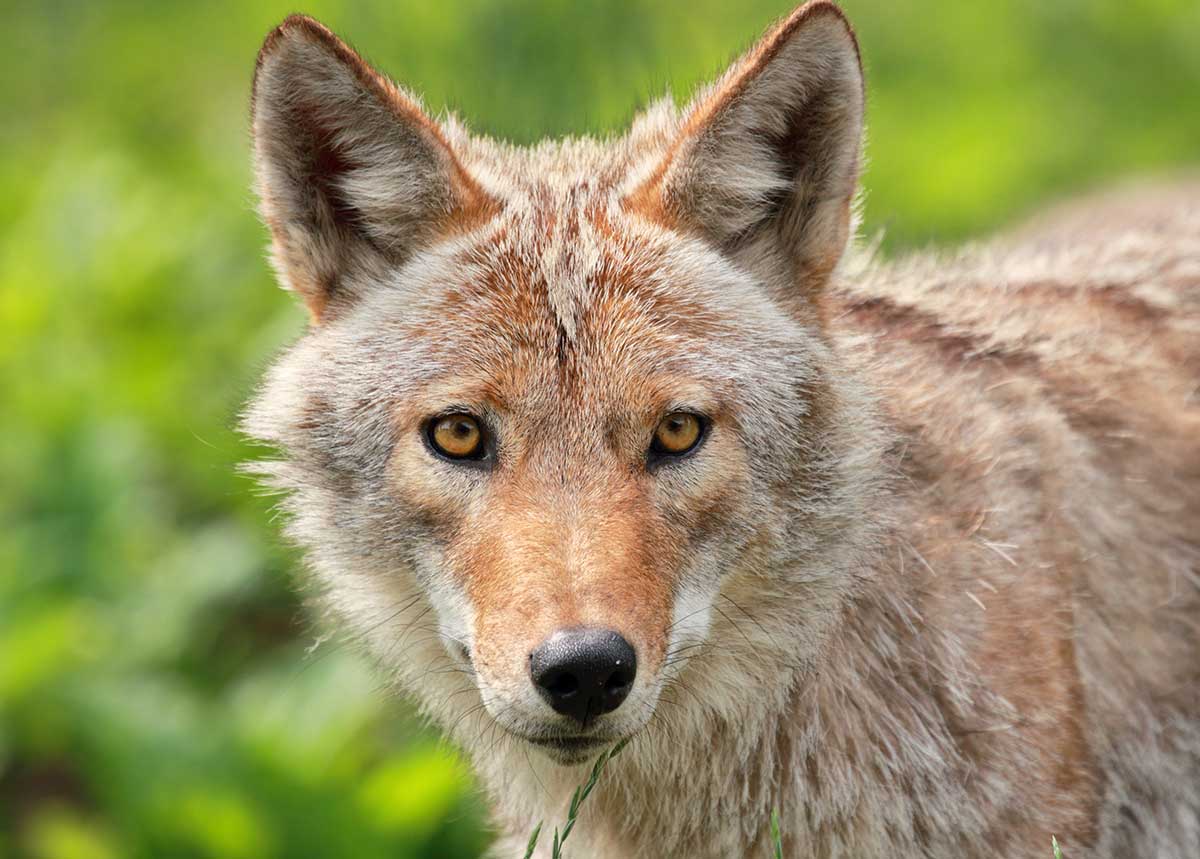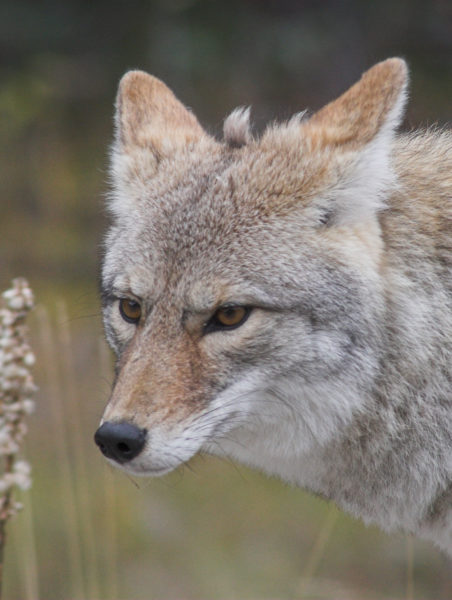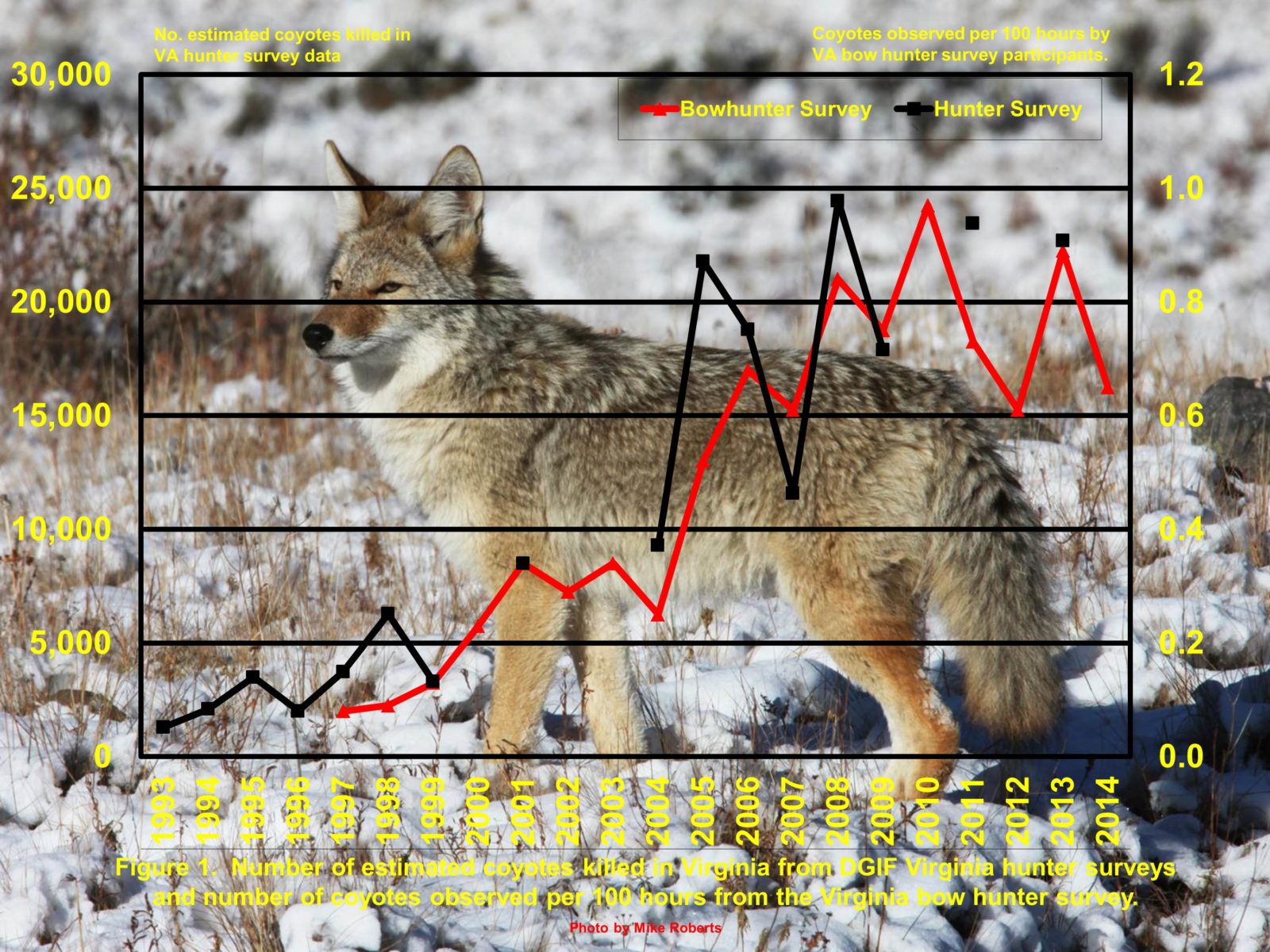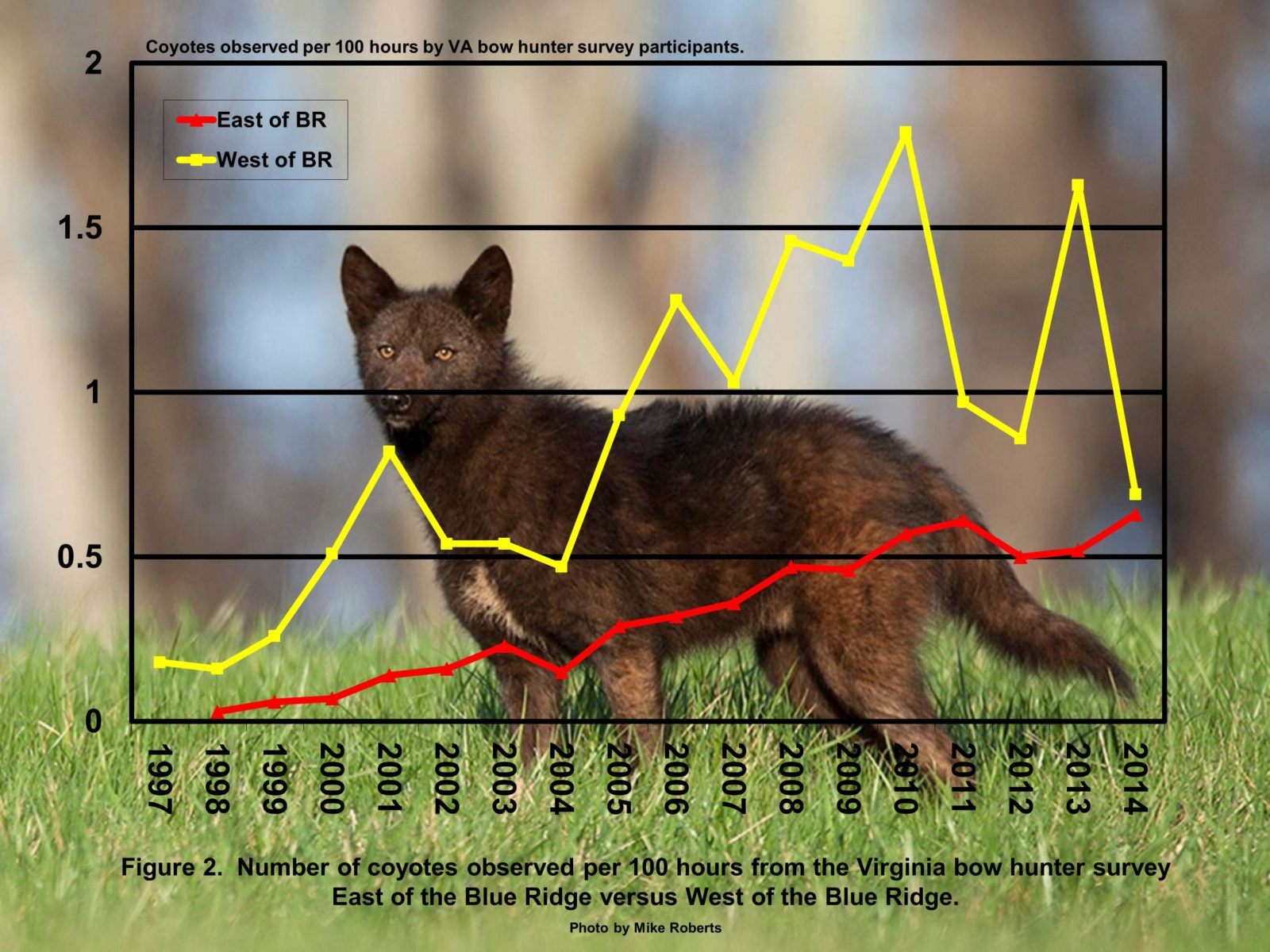
Photo: Shutterstock.
By Matt Knox, Deer Project Coordinator, DWR
Member surveys conducted by the Virginia Deer Hunters Association (VDHA), in spring 2013 and spring 2015, indicated that declining deer herds and coyotes are clearly on the minds of Virginia’s deer hunters. In 2015, when VDHA members were asked, “Do you believe that the ever-increasing number of coyotes have an impact on the deer herd in your county?” 86% said yes, and only 14% said no.
In the past several years, it has been impossible to have a discussion with a deer hunter in Virginia, or anywhere in the eastern United States for that matter, without the topic of coyotes and coyote deer predation coming up. The current popular deer hunting literature is packed with articles demonizing coyotes, stating that they will be the end of deer hunting and deer management as we know it.
Where did the coyotes come from?
First and foremost, no matter what you hear, the Department did not stock coyotes in Virginia. It makes for a great rumor, but it is false.
Over the last 40-plus years, I have watched with great interest as coyotes moved from the west into Mississippi, through Alabama and southern Georgia (where I am from), and then north into South Carolina (where I once worked) and North Carolina before finally coming into Virginia. Decades before the southern half of this pincer movement began, coyotes were moving east and south across the Midwest, through the Great Lake states, and into the Northeast. It would not be a stretch at all to say that Virginia and the mid-Atlantic were the last area in the eastern United States to be colonized by coyotes.

Photo: Shutterstock.
Why did the coyotes come to Virginia?
As most of the large mammalian predators (e.g., cougars, wolves, bears, etc.) were removed from Virginia’s landscape over the last four hundred years, the stage was set for an existing predator (bears) or a new predator (coyotes) to fill the void and seize the opportunity. If nothing else, coyotes are one of the greatest opportunists in nature. French author Francois Rabelais is credited for saying, “Nature abhors a vacuum,” over 500 years ago. The coyotes we now have in the eastern United States are simply Mother Nature filling in a huge predator vacuum. The arrival of an adaptable deer predator like the coyote makes perfect sense and should have been expected.
Is there anything special about coyotes?
Yes, at least five major things in my opinion. First, they are one of the most adaptable animals on earth. They can live in any environment in Virginia, including some of the most densely populated urban areas in the United States. This includes living among the 1.1 million human residents of Fairfax County. Not only do they survive, they thrive.
Second, they thrive because they are the ultimate opportunist/generalist. They can and will eat anything and everything. They eat insects/bugs, small mammals (mice, rats, and rabbits), amphibians, reptiles, birds (including turkeys), larger mammals including groundhogs, raccoons, opossums, cats, dogs, and most importantly deer (fawns, wounded/crippled deer, and possibly healthy adults). I have seen numerous trail camera pictures of coyotes eating corn. Lastly, they are excellent scavengers, eating road kill, garbage, dog food, and agricultural crops like watermelons.
Third, they are very mobile and cover large home range areas. According to coyote research projects Dr. Michael Chamberlin and his associates at the University of Georgia have documented, home ranges for resident coyotes can range from 1,400 to 12,000 acres (~2 – 19 mi2), with an average of about 5,000 acres (~8 mi2). Transient coyotes (i.e., those coyotes without established home ranges) cover much larger areas and, in Dr. Chamberlin’s research, individual coyotes have been documented to disperse and travel distances of several hundred miles or more.
Fourth, they can have high reproductive rates. Because of this, their populations are able to colonize areas quickly and also recover from high mortality rates literally in one breeding season. This makes controlling coyotes, if it can be done (see below), a continuous annual exercise.
Last, they are highly intelligent. Ask any trapper or predator/coyote hunter. Like crows, you may fool them once, but you will not fool them twice.

Figure 1.
How many coyotes are there in Virginia?
The fact is no one knows, but it would be safe to say that coyote populations have exploded and completely spread across the entire state, over the past two decades. When I first moved to Virginia, back in the early 1990’s, I recall that the only places with sizeable coyote populations were some isolated areas in far southwest Virginia and the Alleghany Highland counties. At that time, the public would call in when they saw a coyote, and the Department actually kept data on coyote reports and sightings across most of Virginia. Today, coyotes have become so common that over most of Virginia, sightings are rarely reported, and the Department stopped keeping coyote sighting data many years ago.
The Department’s hunter and bow hunter surveys both illustrate the increase in coyote populations throughout Virginia, over the past several decades (see Figure 1). In recent years, the hunter survey estimates that Virginia hunters are killing about 20,000-25,000 coyotes annually. Twenty years ago, this number would probably have been about 1,000-3,000.
Also, the Department’s 2014 bow hunter survey indicated that statewide an archery deer hunter saw a coyote on average about every 150 hours afield. Back in 1998, when the bow hunter survey was initiated, bow hunters reported seeing a coyote about every 660 hours afield (see Figure 1).
Both surveys indicate that coyote populations were increasing rapidly up until about a decade ago. Since that time, both surveys indicate that coyote populations may have stabilized or are increasing more slowly. Note both surveys still show significant annual variation between years over the past decade.

Figure 2.
One of the most interesting things in the bow hunter survey data is the apparent difference in coyote sighting rates east and west of the Blue Ridge (Figure 2). With the exception of 2014, on average over the past decade, or so, a bow hunter west of the Blue Ridge is about three times more likely to see a coyote per unit time afield than an eastern bow hunter. This data suggests that coyote population densities are higher west of the Blue Ridge Mountains than they are east of the Blue Ridge Mountains and/or coyotes are more visible to bow hunters in western Virginia. It is probably a combination of both.
A recent predator study conducted for the Department by Dr. Marcella Kelly and Ph.D. student Dana Morin, of Virginia Tech, estimated coyote population densities in Bath County at 22 coyotes per 100 square miles (0.22 mi2) and in western Rockingham County at 14 coyotes per 100 square miles (0.14 mi2). Compared to other areas and studies, I am told that these two coyote population density estimates are quite low. In the book Eastern Coyote: The Story of its Success, the author Gerry Parker estimated average coyote densities in the northeastern United States to be around 26-52 per 100 mi2.
After having discussed this issue with several coyote authorities, I would not be surprised at all if coyote densities in many areas of Virginia with good habitat were equal to or greater than a coyote per square mile.
Is the eastern coyote the same as the western coyote?
No. They are different in at least two ways. First, as coyotes made their northern migration swing, recent genetic studies indicate that they hybridized with other canid/dog species. For example, data published in 2014 regarding the northeastern coyote indicates that it is 64% coyote, 13% gray wolf, 13% eastern wolf, and 10% domestic dog (https://www.nps.gov/articles/netn-species-spotlight-eastern-coyote.htm). Other studies show different proportions, but suffice it to say the northeastern coyote is a Heinz 57 coyote with varying degrees of wolf and domestic dog genetics. I did not spend much time looking into coyote genetics, but I would expect that the coyote migration that came from the south contains little to no wolf genetics or influence.
Second, probably because of the dog and wolf genetic influence, the eastern coyote is bigger than the western coyote. Western coyotes average about 20-30 pounds and eastern coyotes generally average between 30 and 40 pounds. Because of Bergman’s rule you would also expect coyote weights to increase from south to north.
Are coyotes having a significant impact on Virginia’s deer herds?
The current answer is that we do not know for sure. Obviously, coyotes are preying on and killing fawns all across Virginia. However, whether or not this predation is having a population level impact is currently unknown. Deer herds are down across much of Virginia, relative to where they were 5-10 years ago, but much of that decline is probably due to liberal seasons and bag limits. Years ago, in my annual deer season forecast articles, I began writing that the large increases seen in Virginia’s recent deer kill numbers were almost entirely due to elevated antlerless deer kill levels, and that elevated antlerless deer kill levels would eventually result in a decline in the statewide deer herd and deer kill numbers. Now we are seeing lower deer herds and lower deer kill numbers, and deer hunters are blaming coyotes. To use a basketball/soccer analogy, the coyotes may deserve an assist, but I still think that liberal either-sex hunting regulations are the primary cause of the reduced deer herds and deer kill.
Ultimately, the truth will come out over the next decade as the Department reduces pressure on the deer herd in certain areas to meet the deer population objectives in the Department’s Deer Management Plan. Many of these adjustments or reductions in female deer kill levels have been made during the last two regulations cycles. If the reduced deer herd and deer kill numbers resulted from liberal regulations, then as the Department backs off pressure, the deer herds and deer kill will respond and come back. Two reviewers of this article noted that the deer population recovery, if it recovers, will be much slower than in the past before coyotes got here. If, however, deer populations are down because of coyote predation, deer populations will remain depressed or decline even more.
If coyote depressed herds occur they will be most likely in poor habitats. For example, the most likely area in Virginia would be the western mountains, where mature forests on thin soils limit deer herd productivity.
If coyotes are a limiting factor on fawn recruitment what could happen?
For the past several decades, Virginia, and most other eastern states, have maintained moderate to low density deer herds with fairly high deer kill/mortality rates. This deer management approach is possible because the heavy hunting losses are offset each year by fawn recruitment. In these deer herds, fawns typically compose a significant proportion of the deer herd at the beginning of each hunting season.
If coyote predation significantly decreased fawn recruitment and high deer kill pressure was maintained on antlerless deer, the deer population and the total deer kill could be expected to decline significantly and quickly.
Additionally, the large annual antlerless deer kill level required to control deer population numbers would have to be reduced significantly. For example in Virginia, instead of killing 200,000+ deer each year, the total annual deer kill could fall to the 150,000 range or even lower.
Surprisingly, overall deer herd condition would improve because there is typically a fairly strong, inverse relationship between deer numbers and deer condition. If deer numbers were significantly reduced, overall deer quality (e.g., weights, antlers, etc.) would actually improve.
Do coyotes kill healthy adult deer?
I used to think not, but when I made this comment in front of one of my deer biologist friends, Dr. Grant Wood, of Missouri, he cautioned that he thought I might be wrong. According to Grant, in certain areas or certain conditions, coyotes may learn to hunt in packs much like wolves. Under these circumstances, Grant indicated that he thought coyotes could be effective predators of healthy adult deer.
Several of my deer biologist peers are of the opinion that coyotes do not routinely prey on healthy adult deer, but coyote predation research projects are inconclusive. In my opinion, the jury is still out on this issue.
What about crippled and wounded deer?
Again, no data, but I think coyotes are probably taking care of much of our current deer hunting wounding/crippling losses. Over the past several years, numerous deer hunters have described a curious behavior in coyotes they see while deer hunting. While they are observing deer, a coyote will appear. The coyote will then go toward the deer just close enough to get them to run off and scatter, then it simply goes about its business like nothing happened. I bet if one of those deer had a pronounced limp or visible injury, the coyote would respond differently. I routinely get calls from deer hunters shooting deer late in the evening stating that coyotes are finding the deer before the hunter does. Twenty years ago, you could leave a deer in the woods overnight and find it the next morning. I did on several occasions. I could not do that today.
Can coyote predation on deer fawns be controlled by coyote hunting and trapping?
Yes and no. Coyotes can be, and are being, controlled on property in some areas by intensive hunting and trapping programs, but success in this effort requires a significant annual investment of time and resources (money). These intensive coyote control programs are typically conducted in late winter and early spring just prior to the fawning season. In some areas, these control efforts have shown good results. In others, they have not. The jury is still out on the fawn recruitment benefits of coyote control programs. One common denominator is that these programs must be conducted annually. With their high reproductive potential, coyote populations are generally able to rebound in a single year.
What is Virginia going to do about coyotes?
As I have noted in previous articles, we are going to learn to live and coexist with coyotes in the future. There is no realistic alternative. I realize this is not a popular opinion with Virginia’s deer hunters.
They are already a nuisance species and can be hunted and shot 24/7/365, but short of declaring them a nuisance species there is not much else that can be done. The typical and historical reaction to coyotes is to institute a bounty system, but several hundred years of experience has proven that these systems don’t work. Our ancestors have been trying to eliminate coyotes from this continent with bounty systems for centuries, and how is that working out?
I was quoted in an online article by Bill Cochran a while back, in which I stated, “If coyotes are the problem (i.e., limiting deer populations), we are screwed.” I stand by that statement. Even if coyote predation was conclusively identified as a controlling factor on Virginia’s deer herds, unless disease outbreaks control coyotes, I do not know or believe that there is any practical or economical way for us as an Agency, or hunters as a group, to control coyote populations over nearly 36,000 square miles of deer habitat.
And coyotes are not the only deer predators we are dealing with in Virginia. Black bears are capable deer fawn predators, and black bear populations are at all-time high numbers across Virginia. There are also bobcats.
Will coyotes fundamentally change deer hunting as we know it in Virginia?
Recently, in some areas of the Southeast, reductions in deer populations have been attributed to coyote predation especially when combined with high antlerless deer kill levels. At the same time, deer appear to have been able to coexist with coyotes in many habitats in the Southeast, Midwest, and Northeast for decades. The question is which coyote/deer relationship will hold true in Virginia? Time will tell.
EDITOR’S NOTE: Matt Knox, a regular contributor to Whitetail Times, is the deer project coordinator for Virginia Department of Wildlife Resources. Knox did his graduate study at the University of Georgia and is an avid deer hunter. Our author welcomes questions and comments from our readers via email at Matt.Knox@dwr.virginia.gov.
©Virginia Deer Hunters Association. For attribution information and reprint rights, contact Denny Quaiff, Executive Director, VDHA.



